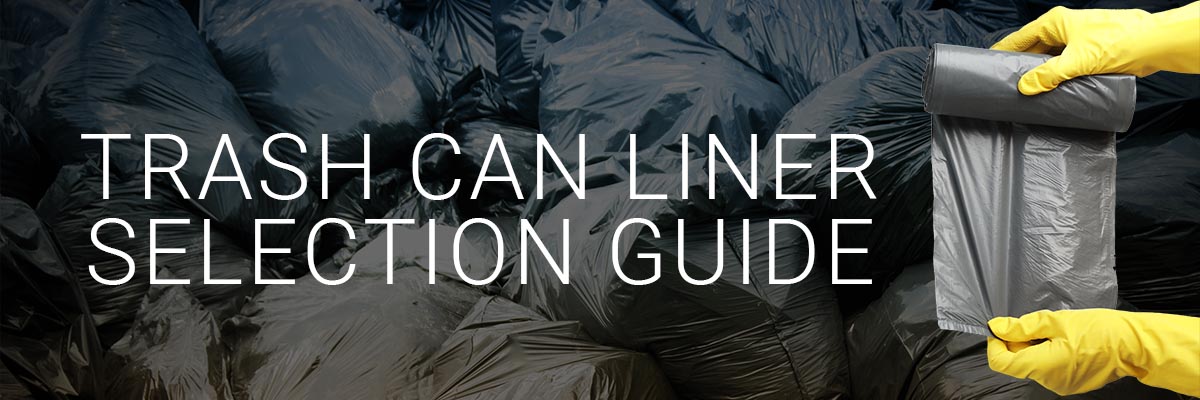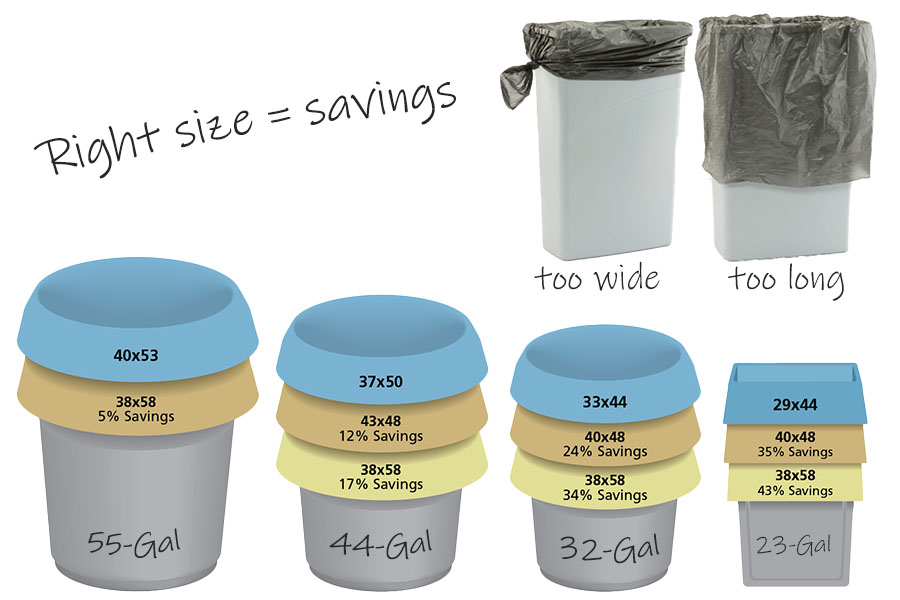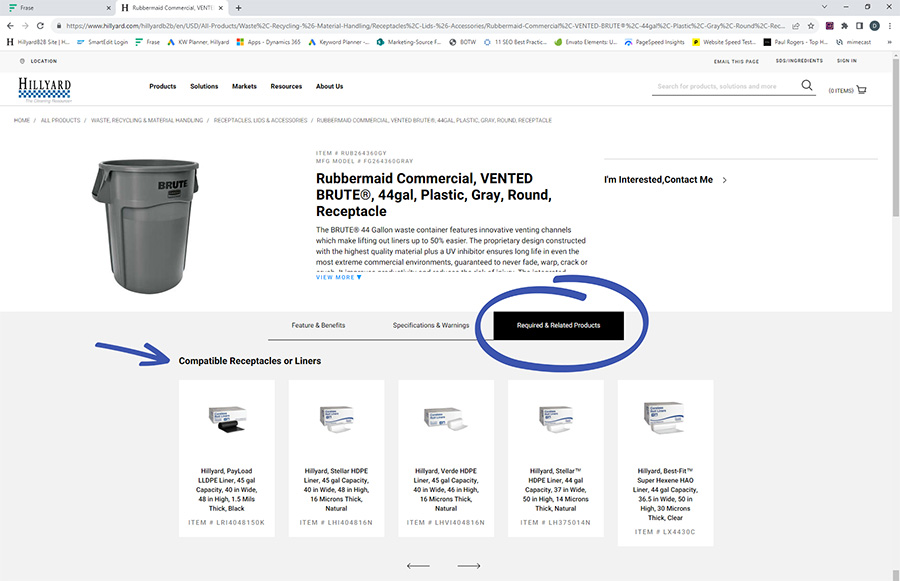Selecting The Best Trash Can Liners For Your Facility
Improve performance, avoid failures, and save money
When maintaining a clean and hygienic facility, choosing the right trash can liner is crucial. The right trash can liner helps facility managers streamline waste disposal and ensure proper sanitation.
One of the main benefits of using the correct liner is the prevention of leaks. Trash can liners that are too flimsy or ill-fitting are prone to tearing and spilling their contents. This not only creates a mess but also wastes valuable labor as janitorial staff need to clean up the mess and replace the liner.

Another advantage of using the right trash can liner is ensuring a proper fit. Using liners that are too small can cause them to slip down into the trash can, leaving the sides exposed and making it difficult to remove the trash bag without a struggle. On the other hand, liners that are too big waste money, as much of the bag material hangs over the side, providing no value.
In this article, we will explain your options and help you decide on the best trash can liners for your facility based on container size and building area.
Are You Using The Right Trash Can Liner?
If you answer "yes" to any of these questions, you need to rethink your can liner selections.
- Do you ever have bag failures?
- Are you double-bagging your receptacles?
- Do your liners ever end up being pulled inside the receptacle?
- Do you need to tie off the bag to make it fit the receptacle?
- Do you have excess plastic hanging over the edge of the receptacle? About 3 to 4 inches is acceptable. More than that, you're wasting money on liners.
- Are you dealing with the mess generated by flat-packed can liners? If yes, consider coreless rolls. Coreless rolls are easier to manage and dispense.
Trash Can Liner Materials
Trash can liners are an essential part of waste management in any facility. Understanding the different materials used to make trash can liners is crucial in determining the right liner for your needs. Here, we will discuss the properties and advantages of the four most common materials used for trash can liners: Hexene, LLDPE, Blended LLDPE, and HDPE.
Hexene:
- Combines the best features of linear low-density and high-density bags.
- Maximum puncture and better tear resistance.
- Handles medium to large loads.
- The safest choice when uncertain about the type of refuse.
LLDPE (Linear Low-Density Polyethylene):
- The most common type of bag used in the industry.
- Offers good puncture and better tear resistance.
- Optimum stretch in the transverse (TD) and machine (MD) direction.
- Film is quiet and smooth compared to high-density films.
- FDA-approved resins available in clear and white colors.
Blended LLDPE:
- Co-Extrusion Process adds great strength, puncture, and tear resistance.
- Extra heavy-duty use in gauges 1-2 mil.
- Good combination of strength and value.
- Minimum 10% post-consumer waste content to meet EPA guidelines.
- Wide range of sizes and gauges available.
HDPE (High-density Polyethylene):
- Stronger than linear low-density liners of the same gauge.
- Greater puncture and tear resistance but less tear resistance once punctured.
- Can withstand extreme temperatures without compromising material integrity.
- Better chemical resistance.
- Improved "barrier properties" virtually eliminate odors when appropriately sealed.
- FDA-approved resins available in natural color.
Choosing the correct trash can liner material depends on your needs and waste requirements. Hexene is ideal for heavy and irregular waste, LLDPE is suitable for everyday use, blended LLDPE is perfect for cost-conscious users in heavy-duty applications, and HDPE is a great all-purpose, cost-effective option.

Calculating the right trash can liner size
A properly fitted bag not only ensures efficient waste collection but also prevents leaks and makes for easier disposal. But how do you calculate the correct size of a trash can liner?
For rectangular receptacles, use these calculations:
| Liner Width |
Liner Length |
Add the length of all four sides and divide by two.
Example for an 11" x 22" x 30" rectangular container:
(11+11+22+22) / 2 = 33 inches |
Add the height of the container to half of the width and add three inches.
Example for an 11" x 22" x 30" rectangular container:
(30 + (22 / 2) + 3) = (30 + 11 + 3) = 44 inches |
For round receptacles, use these calculations:
| Liner Width |
Liner Length |
Multiply the diameter of the container by 3.14 (pi) and divide by two.
Example for a 22" diameter x 27" high container:
22 x 3.14 / 2 = 35 inches (rounded up) |
Add the height of the container to half of the base diameter and add three inches.
Example for a 22" diameter x 27" high container:
27 + (22 / 2) + 3 = 27 + 11 + 3 = 41 inches. |
Let Hillyard Help You Select The Right Liners For Your Facility
Hillyard offers a complete array of waste can liners. Here's a guide to Hillyard's brands:
| Brand Name |
Liner Material |
Description |
| Best-Fit |
HAO Super Hexene |
Best-Fit liners are engineered to save you time and money by ending troublesome bag tie-offs and wasteful liner overhangs. Eliminating overhangs is a sustainable best practice, reducing excess plastic waste from going into landfills. |
| Ultra Pro |
HAO Super Hexene |
Ultra Pro works in the widest variety of applications, including heavy or sharp objects. Use UltraPro whenever you need maximum puncture and tear resistance. |
| Dura Tuff |
LLDPE |
Dura Tuff bags offer dependable performance and are a great, all-purpose solution for industrial, commercial, and institutional applications. Ideal for everything from paper and general refuse to heavy or sharp objects. |
| Payload |
Blended-Recycled LLDPE |
Payload Liners are made from recycled materials, so they're an environmentally preferred choice. Ideal for cost-conscious users looking for a thick bag suited to heavy-duty applications like sharp, heavy, or irregular waste. |
| Stellar |
HDPE |
Stellar liners bring outstanding performance and source reduction to a wide range of waste-containment needs, including food service, commercial, and institutional applications. These liners easily handle non-sharp, heavy, wet waste. |
| Verde |
HDPE or Reprocessed LLDPE |
Verde liners are similar to the Stellar and Payload can liners, with additional recycled content for a more sustainable approach. |
Use Our Online Store To Find Your Liners

We've identified the best liners for each receptacle in our online store (EXAMPLE). Simply find your receptacle and check the "Required & Related Products" Tab. Check out the product carousel at the bottom of the listing for a complete list of recommended liners.
For further assistance with indoor or outdoor garbage cans, use the "I'm interested" form below, and one of our representatives will contact you. In addition to our various trash can models, Hillyard carries recycle bins and sorting stations.
Frequently Asked Questions
What is the difference between can liners and trash bags?
The terms "can liners" and "trash bags" are often used interchangeably, but they can refer to slightly different products based on context and specific use cases. Can liners are primarily designed for use in commercial settings, such as offices, restaurants, and industrial facilities. Can liners often come in a broader range of sizes and thicknesses to accommodate various sizes of waste bins or trash cans used in these environments. In essence, while the terms can be used interchangeably, "can liners" might imply a more heavy-duty and professional-grade product suitable for larger waste containers, while "trash bags" often refer to the everyday bags used in homes, offices, and other general settings.
What are the sizes of trash can liners?
Trash can liners come in various sizes to suit different trash cans and waste bins, typically measured in gallons or liters of capacity. Small liners, around 4-8 gallons or 15-30 liters, are ideal for bathroom or office bins, while medium sizes, approximately 10-15 gallons or 38-57 liters, fit standard kitchen bins. Larger options, ranging from 20 to 30 gallons or 75-114 liters, are suitable for bigger kitchen cans or medium outdoor bins. For substantial needs, extra-large liners at 33 gallons or 125 liters and beyond are designed for larger outdoor or commercial bins. These sizes can vary slightly among manufacturers, so it's advised to verify the packaging details before selecting a liner size that best matches your trash can dimensions and waste disposal requirements.
What is the difference between mil and micron trash liners?
The difference between mil and micron measurements in trash can liners lies in the units used to express thickness. "Mil" is a measurement in thousandths of an inch, with higher mil numbers indicating thicker liners; for instance, a 2-mil liner is thicker than a 1-mil liner. "Micron," on the other hand, is a metric unit representing one-millionth of a meter, used internationally for measuring liner thickness. Generally, as a reference point, 1 mil is approximately equal to 25.4 microns. When comparing trash liners, understanding this distinction is essential, as it ensures you select the appropriate thickness for your needs—whether that's a durable, heavy-duty liner for demanding waste or a thinner option for lighter use—based on the measurement unit provided by the manufacturer.